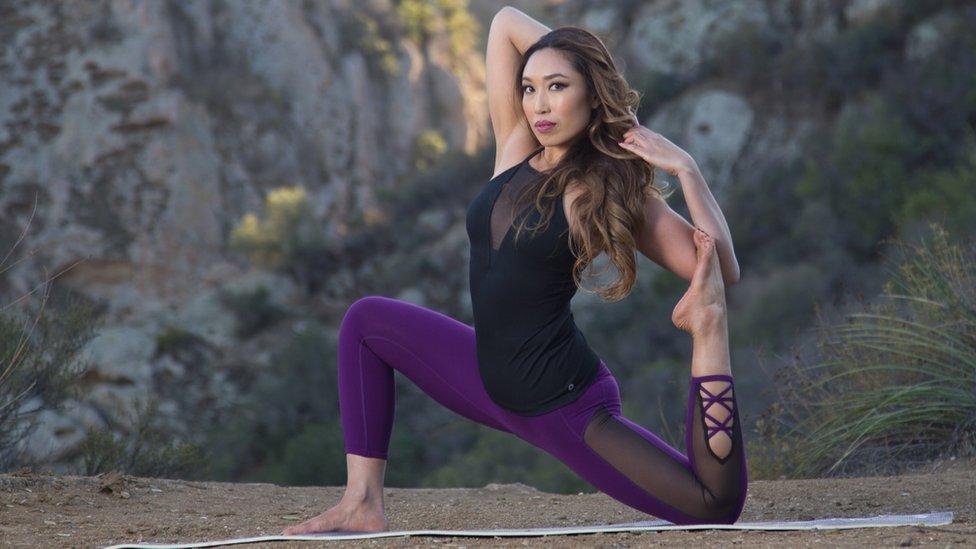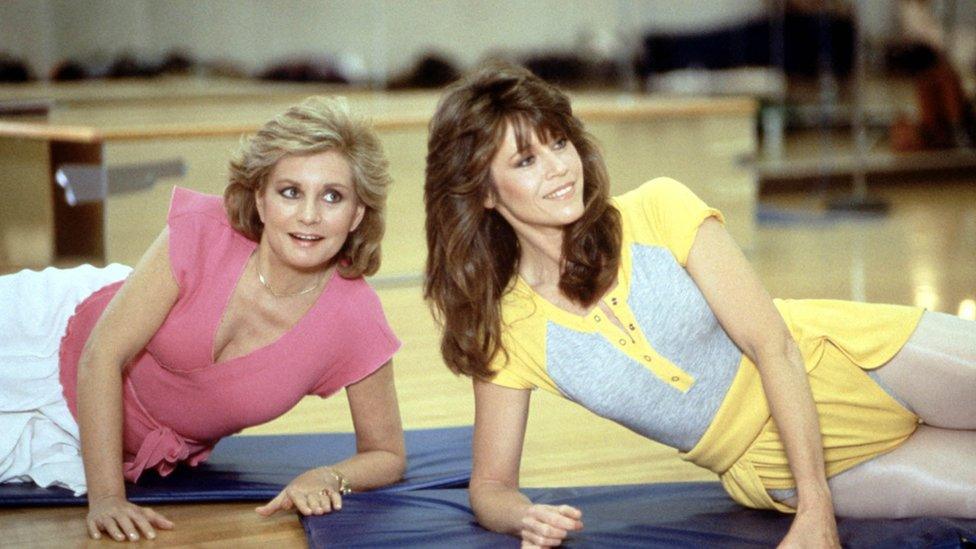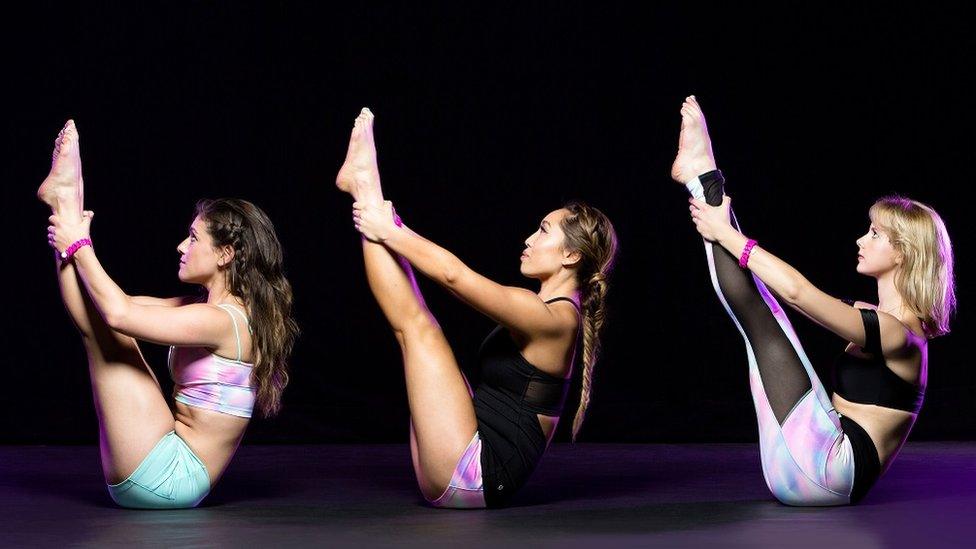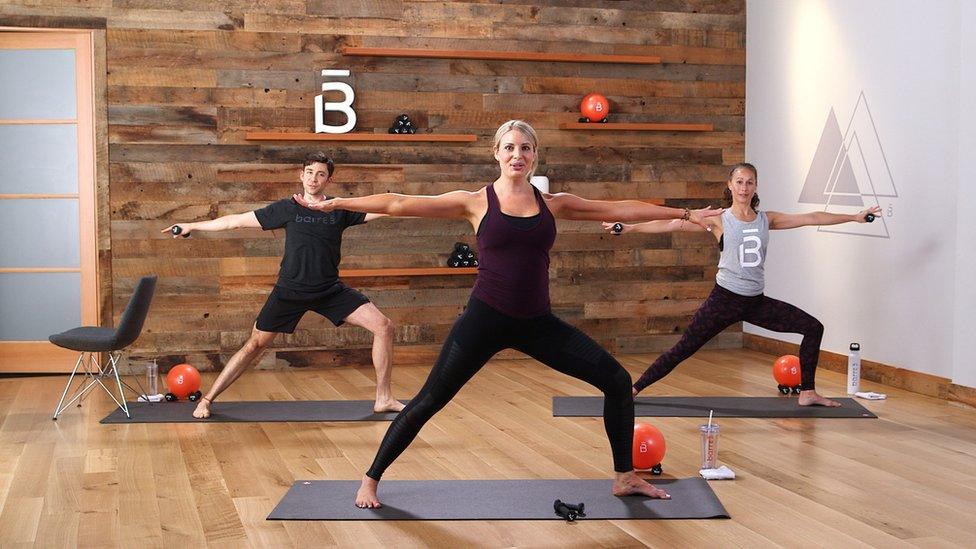How has the fitness video adapted to the YouTube age?
- Published

Pilates devotee Cassey Ho has nearly four million YouTube followers
In the 1980s, a Lycra-clad Jane Fonda sold millions of her pioneering workout video cassettes. But videotape gave way to DVDs, then along came the internet and digital streaming. So how has the workout video adapted?
When Cassey Ho, 30, logs on to her YouTube page "blogilates" and uploads her latest workout video, she knows she will soon be inundated with comments from fans across all her social media accounts.
The fitness video blogger, or vlogger for short, has amassed nearly four million subscribers to her YouTube channel, as well as millions of followers on Facebook and Instagram.
She is one of a new breed of fitness vloggers exploiting the internet's ability to beam content to global mass audiences at very low production costs.
It's a far cry from when fitness queen Jane Fonda inspired millions of people around the world to try aerobics in front of their living room TVs throughout the 1980s. She sold more than 17 million tapes.

Jane Fonda (right) was the fitness video queen in the 1980s
Scores of other models, actors and stars followed suit.
But today, you can find more than 30 million fitness videos on YouTube alone, and countless more on other social media platforms.
Budding fitness kings and queens can publish and gain a following without star status, a fancy studio or thousands of pounds' worth of equipment, simply recording workouts on their smartphones at the beach or in their gardens and editing the content on their laptops.
But unlike the traditional workout video, where weight loss and fitness was the goal, consumers are logging on to their favourite fitness vloggers for a more intimate and interactive experience.
"Fitness videos have switched from being functional to being aspirational content that give people a window into the lives of the fitness influencers they look up to," says Richard Wilson, chief executive of Clickon Media, a content creation firm.
For example, Zuzka Light, a 35-year-old Czech fitness vlogger now based in Los Angeles, started her channel in 2012. Her vlog shows short workout videos, with some of them attracting up to 20 million views.

Fitness vlogger Zuzka Light thinks the "personal approach is really key"
Taking her brand on to other social media platforms, such as Twitter and Instagram, has raised her profile, giving her the opportunity to launch a $9.99 a month subscription to her website and her own clothing and food supplement lines.
"I always try to post videos that I would like to watch myself," she tells the BBC.
"Sometimes it works, sometimes it doesn't. I've had feedback from my viewers who say they feel connected to me and see me as their friend, their workout buddy.
"I think the personal approach is really key."
She regularly works with brands, but admits she's picky about the products she introduces to her audiences.
"Being an influencer I have a responsibility and I wouldn't want to take advantage of that and promote something I wouldn't use myself or something I wouldn't recommend to my loved ones."
More Technology of Business
A study by marketing platform MuseFind found that 92% of people preferred hearing about brands from influencers, rather than through paid adverts.
"This switch in perspective provides marketers and advertisers the freedom to develop more authentic content that tells a story as opposed to being purely functional and demonstrating things such as weight loss and technique," says Mr Wilson.
The fitness sector in general is huge, with the International Health, Racquet & Sportsclub Association reporting that global health club industry revenue reached an estimated $81bn (£63bn) in 2015, with around 151 million members worldwide.
And the fitness clothing industry is worth more than $320bn in the US alone, says the NPD Group.
No wonder vloggers are proving very useful for brands trying to reach consumers directly and bypass the growing use of ad blockers on mobiles and desktops.

Cassey Ho has also developed a group fitness business called POP Pilates
"The growth of smartphone usage and mobile video viewing lends itself well to a fitness audience," says Mark Brill, lecturer in digital communications at Birmingham City University.
"Not only can content be viewed anywhere, but mobile devices also make the interaction personal and more private.
"In the past, word of mouth has been an important way to recommend brands. That has shifted into the digital word of mouth - social media."
And it's not just fitness vloggers benefiting from taking their workouts online.
Fitness studios are realising the potential of live streaming videos of classes and videos featuring their clients' favourite instructors.

Some fitness studios, such as Barre3, are putting classes online to widen their appeal
Barre3, the ballet-based workout in New York, has a subscription-based fitness video service via its website to allow members to exercise from the comfort of their own homes.
Standalone services, such as Flex TV, which provide online access to live high-intensity interval training workouts and yoga classes, are popping up too.
So the traditional workout video on tape or DVD has adapted to a world in which people are more used to streaming entertainment over services such as Netflix, Amazon Prime and YouTube. Declining DVD sales bear this out.
"Fewer people are buying DVDs and it reduces the revenue opportunities for a workout video," says Mr Brill.
"The new revenue comes from advertising share, especially on YouTube, and from sponsorship for those with a large enough social media following.
"Looking at it that way, it seems almost inevitable that the fitness vloggers will triumph."
Follow Technology of Business editor Matthew Wall on Twitter, external and Facebook, external